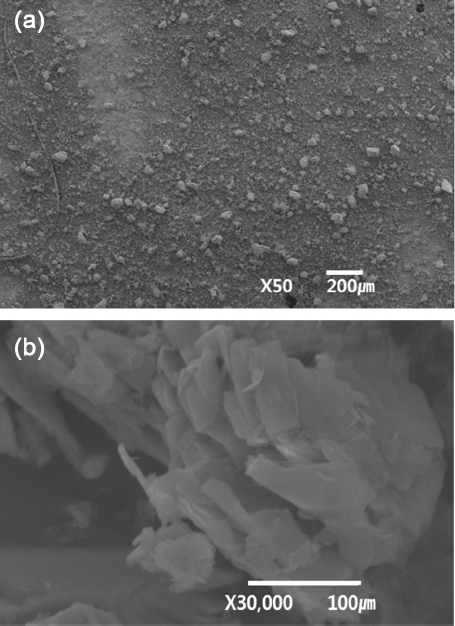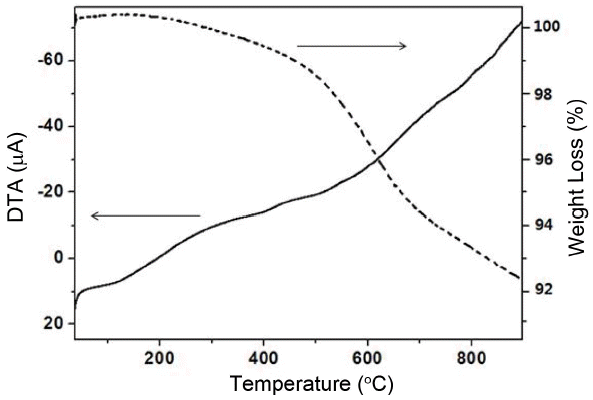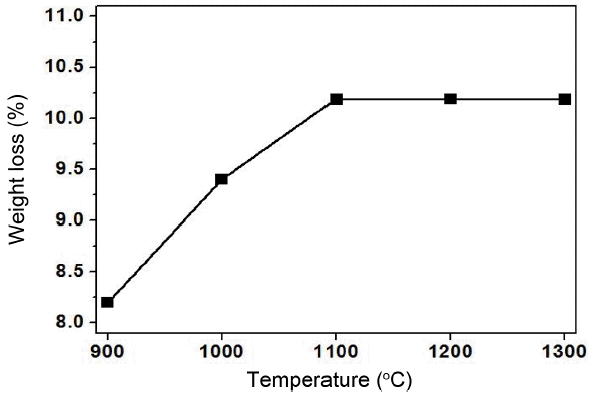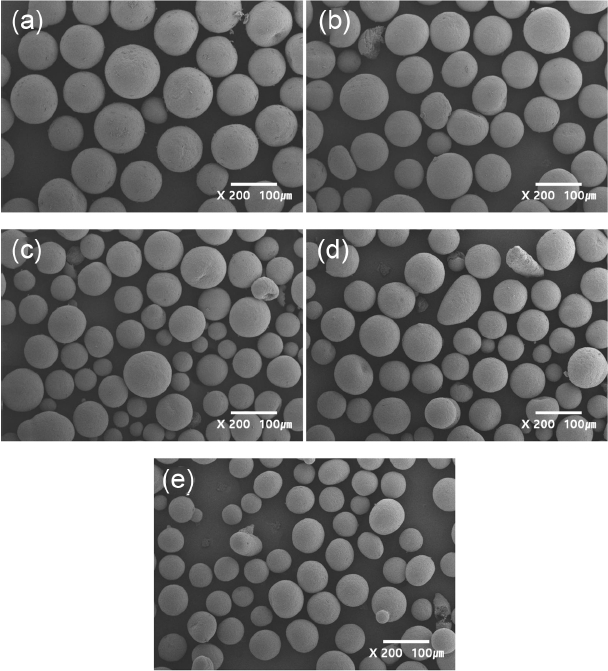1. Introduction
Pyrophyllite (Al2O3·4SiO2·H2O) is a 2:1 lamellar silicate clay mineral where an AlO4(OH)2 octahedral layer is coupled between two SiO4 tetrahedral layers. Our country as the major producer of pyrophyllite has a reserve of about 53 million tons1,2) with its main use as a refractory material 3,4), while its recent uses also include a low-expanding ceramic material,5,6) glass fiber, cement, filler, plastic, tile, powder, china material, etc.2) In particular, as it has a low ignition loss and lower crystal water content compared with kaolin family minerals, it can be used without conversion to chamotte, with easy pulverization as an altered mineral. It is a raw material allowing the use as a ceramic material for thermal spray coating when the pyrophyllite is produced as granule powders. Since the process of thermal spray coating using pyrophyllite granule powders is possible at a very low cost, its utilization for vessel components or marine structures, etc. is expected.
For thermal spray coating where ceramic powders are melted, accelerated and coated, the Atmospheric Plasma Spraying (APS) is frequently used due to its an economic aspect while there are several methods such as APS,7-10) Vacuum Plasma Spray (VPS), High Velocity Oxygen Fuel (HVOF), etc. Since the coating with ceramic materials in plasma thermal spraying method is supplied in the form of powder, manufacturing of spherical granule powders is one of the important technologies.11) Since the powder is transported together with flow of gas for its inflow, the powder should have a sufficient fluidity, and a sufficient strength to prevent the shape from being affected by the flow velocity of gas. Particularly, it can be seen through several literature that particle size and particle size distribution, etc. of the powder are important factors in controlling porosities of the final coating layer.12-14) As the process to manufacture such powders for coating, spray drying is being widely utilized.15-17) Since granules are produced by direct spraying in a slurry state for the spray drying method, uniform mixedness of each component is guaranteed in manufacturing of multicomponent ceramics and the granule powders larger than 20 μm which enable satisfactory flow and filling can be obtained.18) Required in manufacturing of such ceramics granule powders is the control of process variables such as particle size of starting raw material, slurry concentration, drying temperature, spray velocity, etc.
In the present study, the natural resources in Jeollanamdo of pyrophyllite minerals were utilized as a material for thermal spray coating to affirm the application possibility as a material for thermal spray coating. Granule forms of the powder upon spray process will appear as a donut shape, a hollow form in apple shape, and a spherical granule shape. The hollow form occurs as the moisture which failed to escape from inside pierces the surface to be evaporated during drying process of the agglomerated particle in a sprayed liquid droplet state.11) In the case of completely dispersed slurry, the inside moisture is exploded by piercing through the weakest part on the dried surface, or complete explosion of the granule is induced, since no space is left for escape of the moisture inside unable to be evaporated yet as the surface is dried first. When the slurry reaches a partly agglomerated state, empty spaces are generated among loosely lumped powder particles through agglomeration as the surface is being dried, so that the inside moisture is allowed to escape, facilitating formation of spherical granules. Since appropriate dispersion of particles is required within the pyrophyllite powder slurry to prevent hollow shapes, the optimum dispersant content in the slurry was checked through measurement of slurry viscosity for this purpose, and the effects of atomizer’s rotation velocity on the shapes of granule powders were discussed in the present article. The prepared pyrophyllite granule powder was heat treated at diversified temperatures, followed by measurement of apparent density and fluidity.
2. Experimental Procedure
2.1. Analysis of pyrophyllite powder
For the pyrophyllite used as a starting powder, pyrophyllite powder having an average diameter of 45 μm was used, and the observation results of powder form and particle form are shown in Fig. 1. Powders ranging from a few μm to 50 μm can be seen to be distributed in a relatively homogeneous manner. The particle form shows rough surfaces, and the sizes are not uniform, with single particles showing a platy form. This will have ill effects on the fluidity of powder, and the agglomeration strength among particles are so weak that agglomeration is easily broken. Since application of such pyrophyllite powders to thermal spray coating immediately after undergoing only classification process is not feasible without spray process, preparation of a fine particle slurry through pulverization of the powder followed by undergoing the spray process with its use is essential.
2.2. Preparation of granule powders for thermal spray coating
Zirconia balls of 3 mm, 5 mm, and 10 mm in size were incorporated in pyrophyllite powder to the ratio of 1: 2: 3 vol%, and 35 vol% of distilled water compared with the powder was mixed as a solvent, followed by wet ball-milling to prepare the slurry. For dispersion of pyrophyllite powder in the slurry, 0 ~ 0.5 wt% of a dispersant (DISPERBYK, BYK-184) in comparison with the pyrophyllite powder was added. Bubbling phenomenon generated in the ball-milling process was suppressed by using a minor amount of antifoaming agent (DISPERBYK, BYK-028). Wet milling was conducted for 24 h, and then aged for 24 h accompanied by agitation for preparation of the slurry. Pyrophyllite granules were prepared by using a spray dryer (OHKAWARA, FOC-20, Japan). As the conditions for spray process, the inlet temperature was set at 180°C, the outlet temperature at 100°C, and the drying temperature at 180°C. As the atomizer’s rotation velocity was varied from the minimum of 5,000 rpm to the maximum of 15,000 rpm in accordance with viscosities of the slurry, form and particle size of the prepared powders were considered. Since the granule powders contain moisture and organic additives after spray drying, it is instantaneously exposed to a high temperature upon thermal spray coating and then scattered due to explosion of the granules. Thus, heat treatment was conducted at varied temperatures ranging from 900°C to 1,200°C to remove moisture and organic additives from the powder and to maintain the strength, after which individual microstructure was analyzed.
2.3. Analysis of characteristics
For particle size observation of the pyrophyllite powders which underwent ball-milling process and those which were prepared in granules, a particle size analyzer (Photal, ESL- 800, Japan) was employed, with each sample being measured 3 times for derivation of a mean value. For microstructures of the granule particles, powder surfaces were coated with Au-Pd sputter, and observed with a scanning electron microscope (S-3500N, Hitachi, Japan). For measurement of organic contents in the pyrophyllite powder, thermal decomposition behavior as a function of temperature rise was observed by using a thermal analyzer (Santon Redcroft, STA 1500, U.K.), and the analysis was made in air atmosphere at the temperature rise rate of 10°C/min up to 900°C. Viscosity of he pyrophyllite slurry was measured by using a viscometer (Brookfield Viscometer) with the use of spindle LV4 while maintaining the agitation velocity of 100 rpm. To evaluate fluidity of the heat treated pyrophyllite granule powders, flow rates were measured. After filling the hopper capable of holding the volume for 50 g with the prepared granule powder, it was made to flow by self weight, allowing measurement of flow rates according o the equation (1).
The powder weight was measured to three decimal places for calculation, while the flowed time was measured by using a device capable of automatically recording the time through sensing of the flow by using a sensor. Apparent density was calculated according to the equation (2) by measuring weight of the powder placed in the cup to three decimal places after flowing the powder through an orifice of 2.5 mm in hole diameter to be collected in a cup having a volume of 25 cm3 followed by levelling of the powder.
3. Results and Discussion
Figure 2 shows the result of particle size analysis for the pyrophyllite powder of 45 μm in size after pulverization by ball-milling process, exhibiting a particle size distribution with a mean value of 2 ~ 3 μm. In the manufacturing process of granule powders for ceramic thermal spray coating, particle size of the starting ceramic powder will have an effect on inherent characteristics of the powder, amounts of applied additive, mean particle diameter and roughness of granules, etc. Since the particle diameter of granules for thermal spray coating does not exceed 70 μm, the surface of granules often becomes very rough when the diameter of powder particles is large. When the mean particle diameter is shown to be less than 5 μm after undergoing a preliminary experiment, a relatively smooth surface of granules was observed. In the present experiment, such condition was induced when the pyrophyllite powders underwent appropriate ball-milling process.
For consideration of thermal decomposition behavior of the pyrophyllite powders, TG-DTA analyses were performed, the results of which are shown in Fig. 3. No special exothermic and endothermic reactions were observed, and weight reduction by more than 8.2 wt% was observed at about 900°C as continuous ignition loss occurred. The fact that only ignition loss phenomenon was observed without any special reaction phenomenon occurring is attributable to slow realization of decomposition process for the crystal structure as the most of volatile component is crystal water composed of moisture. Based on such results, changes in weight reduction were considered while the prepared granule powders were heat treated up to 1300°C using an electric furnace, and the results are shown in Fig. 4. For the granulated pyrophyllite powders, ignition loss could be affirmed up to 900°C as for the pyrophyllite in powder state, and such weight reduction was also manifested at 1,000°C where densification started while weight reduction by 10.18 wt% was observed at 1,100°C. From 1,100°C and up, no weight reduction was observed, and such results on ignition loss were referred to for determination of temperature range where strength was maintained in heat treatment process of granule powders.
Figure 5 shows changes in the slurry viscosity by varying dispersant contents after preparing the slurry by using the pulverized pyrophyllite powders. When no dispersant was added, the slurry viscosity was higher than 900 cps, suggesting that particles were strongly agglomerated. Upon adding 0.1 wt% of dispersant, dispersion effect was observed with the viscosity being lowered to 100 cps, and further dispersion effect was observed upon addition of 0.2 wt% where the viscosity was lowered to 40 cps. Subsequently, however, no change in viscosity was observed even when the amount of dispersant was increased from 0.3 wt% to 0.5 wt%, suggesting that dispersion was realized to the limit of inherent resistance value as a function of solid contents. For the slurry prepared with 0.2 wt% of dispersant as the minimum dispersant content where no change in viscosity occurred as a result of increase in dispersant contents, slightly hollow-shaped granules after spray process were observed along with granule shapes broken by explosion upon drying, the microstructure of which is shown in Fig. 6. However, in the case of slurry with 0.1 wt% of dispersant added, a spherical shape was observed, as shown in Fig. 7. Granule shapes close to a sphere were observed, with the average size of less than 100 μm being exhibited. While the size of granule powders for thermal spray coating is determined by several variables, it is largely dependent on atomizer’s rotation velocity. In the case of thermally sprayed coating layers, there is a need to control the size of granule powders prepared with variation in atomizer’s rotation velocity, since granule powders with an average size less than 70 μm is required19) as dense layers are generally required although porous layers may be required at times. The results as a function of nozzle’s rotation velocity are shown in Fig. 7. For the atomizer’s rotation velocities of 5,000 rpm and 7,500 rpm, average granule sizes of pyrophyllite larger than 70 μm were observed, and the trend for insignificant reduction in granule size was observed as the rotation velocity was increased. At the rotation velocities of 10,000 rpm and 12,500 rpm, the average granule powder sizes around 70 μm suitable for thermal spray coating were observed. Considering the form and the size of pyrophyllite granule powders, the spray velocity of 12,500 rpm was considered appropriate, and particle size analysis was conducted for the granule powders obtained under this condition, the result of which is shown in Fig. 8. Mean particle size of the powder was shown to be 59.28 μm, and a relatively narrow particle size distribution was observed in comparison with general ceramic granule powders. In comparison with the granule powder prepared with the slurry showing a low viscosity as shown in Fig. 6, the granule powder shown in Fig. 7 represents a relatively narrow particle size distribution, based on which the dispersion state of slurry could be seen to affect not only the hollow shape of granule but also the particle size distribution.
Figure 9 shows a observation result for the microstructure after heat treatment of the pyrophyllite granule powder having a mean size of about 59 μm. In the pyrophyllite granule powders heat treated at 900°C and 1,000°C, insignificant progress of densification among particles could be observed. In the pyrophyllite granule powder heat treated at 1,100°C, particles were observed to be coupled in a more extensive range, and a denser structure was observed in the pyrophyllite granule powder heat treated at 1,200°C in comparison with the sample heat treated at 1,100°C. The pyrophyllite granule powder heat treated at 1,200°C could be affirmed to maintain the shape as was through sieving and classification, while the measured apparent density had a value of 0.725 g/cm3 and a sufficient strength was observed where the form of powders was not affected by the flow rate of gas. The flow rate was shown to have a value of 2.5 g/sec. In another study on thermal spray coating similar to the present study,20) plasma thermal spray coating was conducted by utilizing YSZ (Yttria Stabilized Zirconia) granule powders having an apparent density of 1.66 g/cm3 and a flow rate of 0.732 g/sec, and production of dense coating structures without macroscopic defects or cracks being observed was reported to be feasible. When compared with the above study results, utilization of the pyrophyllite granule powders as the powders for thermal spray coating is shown to be possible as they exhibited the fluidity allowing sufficient spray even at a low gas pressure, accompanied by a satisfactory density.
4. Conclusions
By using pyrophyllite powders of 45 μm class, the granule powders for thermal spray coating were prepared through spray drying process. According to the result of pulverizing the pyrophyllite powder, the sizes suited to manufacturing of the slurries for spray were produced with an average size of 2 ~ 3 μm. For the pyrophyllite slurry intended for spray drying, spherical granules were successfully manufactured by using the slurry showing a viscosity of 100 cps with addition of 0.1 wt% of dispersant. Upon spray process, the pyrophyllite granule powders with a mean size of 59 μm suitable for thermal spray coating were produced at a spray velocity of 12,500 rpm. For the pyrophyllite granule powder heat treated at 1,200°C, strong coupling among particles was observed, showing the characteristics of 0.725 g/cm3 for apparent density and 2.5 g/sec for flow rate. By using the pyrophyllite minerals of 45 μm class, ceramic granule powders enabling general use could be prepared. Hence, through the present study, not only high-value addition of the pyrophyllite but also mass production of good-quality granule powders as the main raw material of ceramics for thermal spray coating is expected.




















